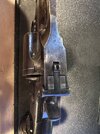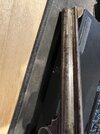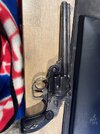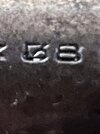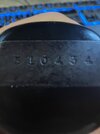Is this something to restore, re-blue, or just put in a case and enjoy? Can someone tell me what it is specifically? Are these old revolvers worth anything to collectors?
You are using an out of date browser. It may not display this or other websites correctly.
You should upgrade or use an alternative browser.
You should upgrade or use an alternative browser.
Dad's old SW 38 any information would be welcome?
- Thread starter Kamp
- Start date
Jim Watson
Member
Smith & Wesson Double Action .38.
I’d have to go get the book to tell which of four or five generally similar sub-models.
They made rather a lot of them, resale value is not high and restoration not much worth it.
I’d have to go get the book to tell which of four or five generally similar sub-models.
They made rather a lot of them, resale value is not high and restoration not much worth it.
Great, thank you for the info.Smith & Wesson Double Action .38.
I’d have to go get the book to tell which of four or five generally similar sub-models.
They made rather a lot of them, resale value is not high and restoration not much worth it.
Hillbilly Hydrographics
Member
I say get her checked out to see if she's safe and then enjoy the hell out of firing the old gal. They are fun shooters.
Monac
Member
I don't think they made that model in anything other than 38 S&W. That is a shorter cartridge than 38 S&W Special, and the two are not interchangeable. I think the old standard 38 S&W load with a bullet of about 148 grains at about 700 ft/sec has about 150 ft/lbs of kinetic energy as the muzzle, which would be about 3/4 of the kinetic energy of the old standard 158 grain 38 Special load. If I am remembering things correctly today, anyway.those are great and if I had that you could not get me to sell it. What cartridge does it say stamped on it?
PS - both the grips and the sights on these old S&W's are tiny. I don't know anything you can do about the sights, but as I understand, S&W has never changed the basic shape of these small-frame grips, so any modern "J-frame" grip will fit it. That was certainly true for my 38 S&W Perfected Model, which was the immediate successor to this model. I've never had one of these, though.
At one time you could buy one of those for $12 bucks! Money was worth a lot more than

I do not believe that these there 38 Special revolvers. The 38 S&W cartridge was different.
Now the thing is, these 1900 period revolvers were made from plain carbon steels, that had a lot of residuals in the steel. So today's equivalent steels (which would be the stuff used now for lawn mower blades and rail road spikes) are likely to be stronger because modern smelting technology removes the stuff that could not be removed with Bessemer or Open Hearth furnaces. And, this is a big one, those pistols were not heat treated. The steels were dead soft.
So, whatever you put in the cylinder, you want the lowest pressure you can find. Nothing remotely near a +P round. You will find that if you put hot loads in a vintage top strap revolver, you will stretch the top strap!

I do not believe that these there 38 Special revolvers. The 38 S&W cartridge was different.
Now the thing is, these 1900 period revolvers were made from plain carbon steels, that had a lot of residuals in the steel. So today's equivalent steels (which would be the stuff used now for lawn mower blades and rail road spikes) are likely to be stronger because modern smelting technology removes the stuff that could not be removed with Bessemer or Open Hearth furnaces. And, this is a big one, those pistols were not heat treated. The steels were dead soft.
So, whatever you put in the cylinder, you want the lowest pressure you can find. Nothing remotely near a +P round. You will find that if you put hot loads in a vintage top strap revolver, you will stretch the top strap!
Jim Watson
Member
What is the serial number on the butt of the gun? The number on the cylinder does not fall within the range for the model.
I don't think standard brands of .38 S&W are loaded any hotter than it was when smokeless ammo first came out.
Buffalo Bore sells a version that is meant for solid frame revolvers and the WWII Webley.
But it was past the turn of the century before Colt and Smith "rated" their revolvers for smokeless.
That 1902 catalog likely has smokeless ammo, I know my 1901 does. I bet Grandpa bought it when he could afford it, no matter what the warning on the gun box lid said.
I think the limit is on volume. I would not shoot a topbreak revolver anything like the amount I shoot a "modern" hand ejector. An even earlier .38 Single Action served me as a CAS Pocket Pistol but it only got shot 5 or 10 times in a match and not a lot of practice time.
I don't think standard brands of .38 S&W are loaded any hotter than it was when smokeless ammo first came out.
Buffalo Bore sells a version that is meant for solid frame revolvers and the WWII Webley.
But it was past the turn of the century before Colt and Smith "rated" their revolvers for smokeless.
That 1902 catalog likely has smokeless ammo, I know my 1901 does. I bet Grandpa bought it when he could afford it, no matter what the warning on the gun box lid said.
I think the limit is on volume. I would not shoot a topbreak revolver anything like the amount I shoot a "modern" hand ejector. An even earlier .38 Single Action served me as a CAS Pocket Pistol but it only got shot 5 or 10 times in a match and not a lot of practice time.
38 SWthose are great and if I had that you could not get me to sell it. What cartridge does it say stamped on it?
At one time you could buy one of those for $12 bucks! Money was worth a lot more than

I do not believe that these there 38 Special revolvers. The 38 S&W cartridge was different.
Now the thing is, these 1900 period revolvers were made from plain carbon steels, that had a lot of residuals in the steel. So today's equivalent steels (which would be the stuff used now for lawn mower blades and rail road spikes) are likely to be stronger because modern smelting technology removes the stuff that could not be removed with Bessemer or Open Hearth furnaces. And, this is a big one, those pistols were not heat treated. The steels were dead soft.
So, whatever you put in the cylinder, you want the lowest pressure you can find. Nothing remotely near a +P round. You will find that if you put hot loads in a vintage top strap revolver, you will stretch the top strap
It's interesting you mention the "Soft" steel, I can see almost no rifling left in the barrel, I imagine due to the softness of the steel that's a pretty common problem in these old revolvers.
Jim Watson
Member
Looks like 510434 is the serial number Jim.
That makes it a 4th Model made between 1895 and 1909, probably late in that period.
Is that a 6" barrel? If so, listed as "scarce."
Yes it's a 6" barrel.That makes it a 4th Model made between 1895 and 1909, probably late in that period.
Is that a 6" barrel? If so, listed as "scarce."
1976B.L.Johns.
Member
Happy happy, joy, joy!Yes it's a 6" barrel.
Similar threads
- Replies
- 6
- Views
- 763
- Replies
- 1
- Views
- 640


![IMG_1839[1].JPG](/data/attachments/1117/1117777-c6781962e0e582358e0f9b926aab5044.jpg)
![IMG_1840[1].JPG](/data/attachments/1117/1117778-26ef8dcf573f9db1b61466b3be688422.jpg)
